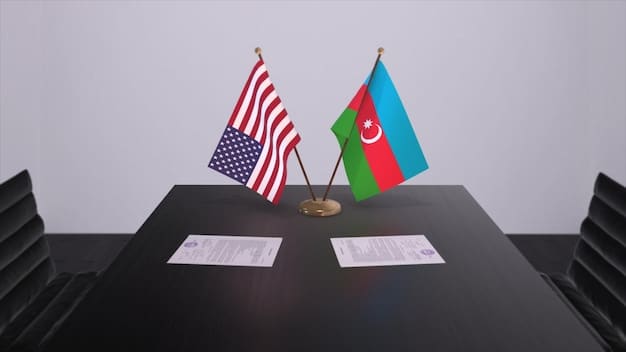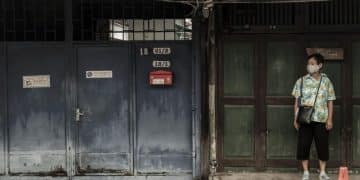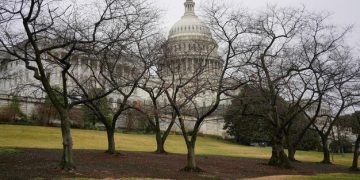US and Iran Nuclear Deal: Re-Engagement Options for 2025

The US and the Iran Nuclear Deal: Exploring Options for Re-Engagement in 2025 examines potential pathways for the United States to rejoin or renegotiate the Joint Comprehensive Plan of Action (JCPOA) amidst evolving geopolitical dynamics and concerns over Iran’s nuclear program.
The future of the US and the Iran Nuclear Deal: Exploring Options for Re-Engagement in 2025 remains uncertain, with significant implications for regional stability and nuclear non-proliferation efforts. This article delves into the potential strategies and challenges facing the United States as it considers re-engagement with Iran in 2025.
The Complex History of the JCPOA
Understanding the context behind the Joint Comprehensive Plan of Action (JCPOA) is crucial for evaluating future re-engagement options. The JCPOA, commonly known as the Iran Nuclear Deal, was the product of years of international diplomacy aimed at preventing Iran from developing nuclear weapons.
Key Milestones in the JCPOA’s Formation
The JCPOA was not created overnight; it was the culmination of numerous diplomatic efforts and negotiations. Several key milestones led to its eventual signing.
- Initial Negotiations: Preliminary talks began in secret between US and Iranian officials in 2012, laying the groundwork for broader negotiations involving other world powers.
- P5+1 Agreement: Negotiations expanded to include the P5+1—the five permanent members of the UN Security Council (United States, United Kingdom, France, China, and Russia) plus Germany—resulting in a framework agreement in 2015.
- Finalization of the JCPOA: The final agreement was signed in Vienna on July 14, 2015, outlining the terms and conditions for Iran’s nuclear program and international sanctions relief.
The Original Terms of the Agreement
The JCPOA included specific provisions designed to limit Iran’s nuclear capabilities and ensure international monitoring. These terms were central to the agreement’s goals.
These provisions are designed to address concerns about Iran’s nuclear program.
- Restrictions on Uranium Enrichment: Iran agreed to limit its uranium enrichment to 3.67%, far below the level needed for weapons-grade material.
- Reduction of Centrifuges: The number of centrifuges used for uranium enrichment was significantly reduced, limiting Iran’s capacity to produce enriched uranium.
- International Inspections: The International Atomic Energy Agency (IAEA) was granted access to Iranian nuclear facilities to monitor compliance with the agreement.
The JCPOA represented a significant diplomatic achievement, but its future remains uncertain. The next section explores the US withdrawal from the agreement and its impact.
In summary, the JCPOA aimed to curb Iran’s nuclear ambitions through strict limitations and monitoring. The agreement’s history and terms are vital to understanding the challenges and opportunities for re-engagement in 2025.
The US Withdrawal and Its Consequences
The US decision to withdraw from the JCPOA in 2018 marked a turning point in the agreement’s history. This decision had far-reaching consequences for both Iran and the international community.

Rationale Behind the Withdrawal
The Trump administration cited several reasons for withdrawing from the JCPOA. These included concerns about the agreement’s sunset clauses, its failure to address Iran’s ballistic missile program, and its lack of focus on Iran’s regional behavior.
The administration argued that the JCPOA was too lenient on Iran and did not prevent it from pursuing nuclear weapons in the long term. It also claimed that the agreement provided Iran with financial resources that were used to support destabilizing activities in the region.
Here are further factors influencing the withdrawal.
- Sunset Clauses: Critics argued that the JCPOA’s sunset clauses, which lifted restrictions on Iran’s nuclear program after a certain period, were a major flaw.
- Ballistic Missile Program: The agreement did not address Iran’s development and testing of ballistic missiles, which posed a threat to regional security.
- Regional Behavior: The US also raised concerns about Iran’s support for proxy groups and its involvement in conflicts in Yemen, Syria, and Lebanon.
Impact on Iran’s Nuclear Program
Following the US withdrawal, Iran began to gradually roll back its compliance with the JCPOA. This included increasing uranium enrichment levels, restarting centrifuge production, and reducing cooperation with IAEA inspectors.
These actions raised concerns about Iran’s intentions and brought it closer to having the capability to develop nuclear weapons. The international community has struggled to find a way to bring Iran back into full compliance with the agreement.
In conclusion, the US withdrawal from the JCPOA and its subsequent consequences have created a complex and challenging situation. The next section explores potential pathways for re-engagement in 2025.
The withdrawal and the subsequent actions by Iran have significantly complicated the prospects for future negotiations.
Potential Pathways for Re-Engagement in 2025
As 2025 approaches, several pathways exist for the US to re-engage with Iran on the nuclear issue. Each of these pathways presents its own set of opportunities and challenges.
Rejoining the Original JCPOA
One option is for the US to rejoin the original JCPOA without preconditions. This would involve lifting sanctions that were reimposed after the US withdrawal and returning to full compliance with the agreement.
However, this approach faces significant political obstacles in the US, where many policymakers believe that the original JCPOA was flawed and insufficient to address Iran’s nuclear ambitions.
Let’s examine some of the pros and cons of this approach.
- Pros: Restores international consensus, quickly addresses immediate proliferation risks, allows for future negotiations on broader issues.
- Cons: Does not address sunset clauses, ballistic missile program, or regional behavior; faces domestic political opposition.
Negotiating a Modified Agreement
Another option is to negotiate a modified agreement that addresses the concerns raised by the US and other parties. This could involve extending the sunset clauses, including provisions on Iran’s ballistic missile program, and addressing its regional behavior.
However, negotiating a new agreement would be a complex and time-consuming process, and there is no guarantee that Iran would be willing to accept additional restrictions on its nuclear program.
Negotiating any new agreement would be a significant undertaking.
- Pros: Addresses key shortcomings of the original JCPOA, potentially leads to a more comprehensive and durable agreement.
- Cons: Requires extensive negotiations, faces potential Iranian resistance, may not be achievable in the near term.
Interim Agreements and Confidence-Building Measures
A third option is to pursue interim agreements and confidence-building measures as a stepping stone towards a broader agreement. This could involve limited sanctions relief in exchange for Iran taking steps to reduce its uranium enrichment levels and increase cooperation with the IAEA.
Such measures could help to de-escalate tensions and create a more conducive environment for future negotiations.
Interim agreements are a common approach to complex diplomatic challenges.
- Pros: De-escalates tensions, builds trust, creates a foundation for future negotiations.
- Cons: May not fully address long-term concerns, requires careful monitoring and verification, could be seen as insufficient by some parties.
Choosing the right pathway will require careful consideration of the political, technical, and diplomatic factors involved.
In conclusion, re-engagement with Iran will require careful diplomacy and a willingness to compromise. The next section explores the role of international diplomacy in achieving this goal.
The Role of International Diplomacy
International diplomacy will play a crucial role in any effort to re-engage with Iran on the nuclear issue. The involvement of key players such as the European Union, Russia, and China will be essential for achieving a successful outcome.

The Importance of the P5+1
The P5+1 countries were instrumental in negotiating the original JCPOA, and their continued involvement will be critical for any future agreement. These countries have a shared interest in preventing Iran from developing nuclear weapons and maintaining regional stability.
However, differences in their approaches and priorities could complicate the process. It will be important to find common ground and work together to address the challenges.
The P5+1 brings a unique set of perspectives and capabilities to the table.
- Maintaining Consensus: Ensuring that all P5+1 members are aligned on the goals and strategies for re-engagement.
- Leveraging Influence: Using their diplomatic and economic leverage to encourage Iran to return to compliance with the JCPOA.
- Providing Support: Offering technical and financial assistance to support Iran’s peaceful use of nuclear energy.
The Role of the European Union
The European Union has been a strong supporter of the JCPOA and has worked to preserve the agreement despite the US withdrawal. The EU can play a key role in facilitating dialogue between the US and Iran and bridging differences between the parties.
The EU can also provide economic incentives for Iran to return to compliance with the JCPOA, such as easing sanctions and promoting trade and investment.
The EU has a long history of diplomatic engagement in the Middle East.
- Facilitating Dialogue: Providing a neutral platform for discussions between the US and Iran.
- Offering Economic Incentives: Easing sanctions and promoting trade and investment to encourage compliance.
- Providing Technical Assistance: Supporting Iran’s peaceful use of nuclear energy and monitoring its compliance with the JCPOA.
International diplomacy can help to create a more conducive environment for re-engagement.
In conclusion, international cooperation and coordination will be essential for achieving a successful outcome. The next section explores the domestic political considerations that will shape the US approach to re-engagement.
Domestic Political Considerations in the US
Domestic political considerations in the US will significantly influence the approach to re-engaging with Iran. The issue has become highly politicized, and there are sharp divisions between Democrats and Republicans on the best way forward.
Public Opinion and Congressional Support
Public opinion on the Iran nuclear deal is divided, with varying levels of support depending on political affiliation and views on foreign policy. Strong congressional support, particularly from both parties, will be essential for any re-engagement strategy to succeed.
Without bipartisan support, any agreement reached with Iran could be vulnerable to being overturned by a future administration.
Understanding public and congressional sentiments is paramount.
- Building Public Support: Communicating the benefits of re-engagement for US national security and regional stability.
- Engaging with Congress: Seeking input from both Democrats and Republicans and addressing their concerns.
- Highlighting the Risks of Non-Engagement: Emphasizing the dangers of Iran developing nuclear weapons and the potential for regional conflict.
The Impact of US Elections
The outcome of US elections can have a significant impact on the future of the Iran nuclear deal. A change in administration could lead to a shift in policy, either towards re-engagement or continued confrontation.
Therefore, it is important to consider the potential implications of US elections when evaluating options for re-engagement.
U.S. elections are pivotal moments that can reshape foreign policy.
- Policy Continuity: The need for a consistent and stable approach to Iran, regardless of which party is in power.
- Potential Policy Shifts: The possibility of a change in administration leading to a different approach to the JCPOA.
- Election Rhetoric: The impact of campaign rhetoric on the prospects for re-engagement.
Considering these political factors is a practical necessity for formulating action plans.
In conclusion, domestic political considerations will play a crucial role in shaping the US approach to re-engagement with Iran. The next section explores the broader regional implications of this issue.
Regional Implications of US-Iran Relations
The relationship between the US and Iran has significant implications for regional stability in the Middle East. Tensions between the two countries have fueled conflicts and proxy wars throughout the region.
Impact on Regional Conflicts
The US and Iran support opposing sides in several regional conflicts, including those in Yemen, Syria, and Lebanon. A re-engagement between the two countries could help to de-escalate these conflicts and promote a more stable regional order.
However, it could also be seen as a betrayal by some of the US’s regional allies, such as Saudi Arabia and Israel, who view Iran as a major threat.
Regional conflicts are often exacerbated by the US-Iran dynamic.
- De-escalation of Conflicts: Helping to resolve regional conflicts through diplomatic means.
- Supporting Regional Stability: Promoting a more stable and peaceful regional order.
- Addressing Humanitarian Crises: Working to alleviate the suffering of people affected by regional conflicts.
Relations with Saudi Arabia and Israel
Saudi Arabia and Israel are key US allies in the Middle East, and their concerns about Iran’s nuclear program and regional behavior must be taken into account. Reassuring these countries that their security interests will be protected is essential for maintaining regional stability.
This could involve strengthening security cooperation with Saudi Arabia and Israel and working together to counter Iran’s destabilizing activities.
The security of US allies is a critical consideration.
- Strengthening Security Cooperation: Enhancing military and intelligence cooperation with Saudi Arabia and Israel.
- Providing Security Guarantees: Offering assurances that the US will stand by its allies in the face of Iranian aggression.
- Addressing Concerns: Taking Saudi Arabia and Israel’s concerns about Iran’s behavior seriously.
Balancing regional dynamics while pursuing national interests requires astute judgement.
In conclusion, the regional implications of US-Iran relations are far-reaching and complex. Addressing these implications will require a comprehensive and nuanced approach.
| Key Point | Brief Description |
|---|---|
| 🔑 JCPOA History | The JCPOA aimed to curb Iran’s nuclear ambitions through strict limitations and monitoring by international agencies. |
| 💔 US Withdrawal | The US withdrawal led to Iran gradually rolling back compliance, raising concerns about its nuclear capabilities. |
| 🤝 Re-Engagement Options | Options include rejoining the original JCPOA, negotiating a modified agreement, or interim steps. |
| 🌍 Diplomacy | International diplomacy, especially the P5+1 and the EU, is vital for successful re-engagement. |
Frequently Asked Questions
▼
The JCPOA, or Iran Nuclear Deal, aimed to prevent Iran from developing nuclear weapons by imposing restrictions on its nuclear program and allowing international inspections.
▼
The US withdrew due to concerns about sunset clauses, Iran’s ballistic missile program, and regional behavior, deeming the agreement too lenient.
▼
Options include rejoining the original JCPOA, negotiating a modified agreement addressing concerns, or interim agreements for confidence-building.
▼
International diplomacy, especially from P5+1 countries and the EU, is vital and can help provide economic incentives and mediate dialogue.
▼
Domestic political considerations, public opinion, Congressional support, and election results significantly influence the US approach to re-engagement.
Conclusion
In conclusion, the path forward for the US and the Iran Nuclear Deal: Exploring Options for Re-Engagement in 2025 is complex and multifaceted, requiring consideration of historical context, domestic politics, regional implications, and international diplomacy. Successfully navigating these challenges will be essential for preventing nuclear proliferation and promoting stability in the Middle East.





